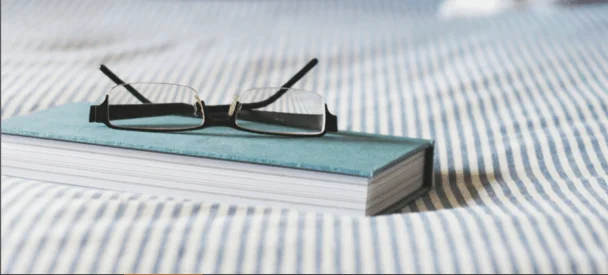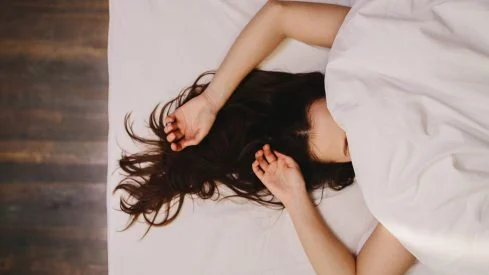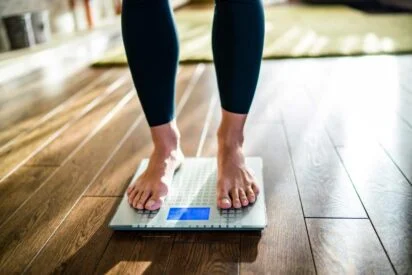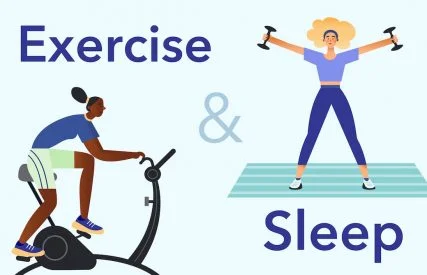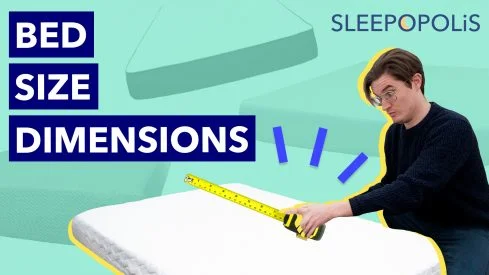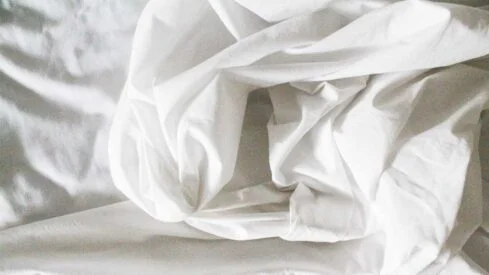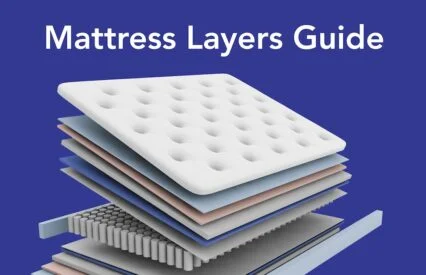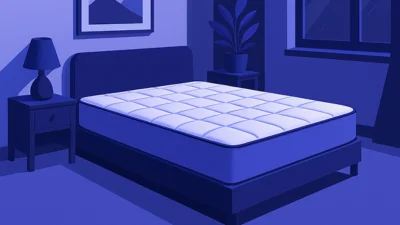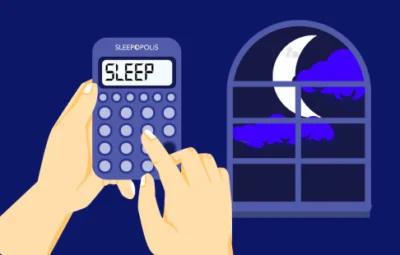Episode 2: Does It Really Matter What Kind of Mattress You Sleep On? And Other Sleep Questions
Listen and subscribe:
Shownotes
Can my sleeping position impact the mattress I should sleep on? Do cooling mattresses really exist? Do I really have to spend $2,000 on a mattress to get a good night’s sleep? Yes, yes, and no!
The mattress you sleep on can have a huge impact on the overall quality of your sleep – but trying to sift through the hundreds of online options and pinpoint which one is right for you (or your family or kids) can be overwhelming. (It’s enough to make you want to lie down and take a nap.)
That’s where we come in. In the latest episode of Sleep Talking with Dr. Shelby, we answer all those questions and more to help you make the right buying choice for yourself or your loved ones.
Tune in to hear Dr. Harris and Sleepopolis Senior Staff Writer, Amelia Jerden, talk through the most common questions we get from listeners and readers about how to find the perfect sheets for you, what the difference between an innerspring and hybrid mattress really is, whether a higher thread count really is better, and how to find the perfect weighted blanket for you. By the end of the episode, you’ll be a sleep-shopping pro.
Helpful resources and episode-related links:
- Your Complete Mattress Glossary
- The Absolute Best Mattresses of the year
- The Best Mattresses for Side Sleepers
- The Best Mattresses for Stomach Sleepers
- The Best Mattress for Back Sleepers
- The Best Mattresses for Heavy People
- The Best Cooling Mattresses
- The Black Friday and Cyber Monday Deals You Don’t Want to Miss
Transcript
Amelia Jerden: A higher thread count basically just means it’s more tightly woven, right? Like, the more threads you’ve got in that square inch, the tighter the fabric is. So there’s really, kind of, a limit on how many threads can actually fit in that square inch.
And so a lot of times what some companies will actually do is they’ll, like, twist two threads together. Basically double the threads. Because there’s this consumer belief that a higher thread count is better.
Dr. Shelby: Yes!
AJ: And so that’s why you get these astronomical like 1,000- or 1,500-thread count. And it’s really not necessarily a lot better and actually maybe worse in some cases. Not necessarily drastically worse quality, but you’re probably paying for something that you basically don’t really need.
DS: Oh, interesting. I learned something new there.
DS: Welcome to Sleep Talking with Dr. Shelby, where we really want to know, how are you sleeping? Really, are you sleeping? Two-thirds of Americans wake up feeling groggy and weird, wondering why they were up at three in the morning. Wondering if there’s something wrong with them. If that sounds like you, you have come to the right place.
I’m Dr. Shelby Harris, a licensed Clinical Psychologist, and I’m the director of sleep health at Sleepopolis, where we dive deep into all things sleep, so you can get the rest that you deserve.
Today, we’re answering your questions, listeners. Yes, your questions that you’ve submitted online and to my Instagram, everything you want to know about sleep. So, here’s a huge thank you to all of my listeners who sent in their sleep related questions for this episode. We appreciate them so much, and I really appreciate you listening.
We’re always collecting more questions for future episodes through Instagram, Facebook, and Twitter, at Sleepopolis and at Sleep Doc Shelby. So, listeners, if there’s anything else you’d like to hear us talk about on the show, keep the questions coming. I could talk sleep all day long.
In the meantime, though, you’ve given us plenty of burning questions to dig into. Like, does a higher thread count make a difference? And does it really matter what kind of mattress I sleep on?
To uncover answers to all these and more, we’ve invited Sleepopolis Senior Staff Writer, Amelia Jerden. On an average day at work, you can find Amelia testing out products like mattresses, pillows, sheets, mattress toppers, and more, or writing up detailed reviews about her experience testing them out. This makes her the perfect person to answer your burning questions about sleep.
Amelia, thanks so much for joining us and welcome to Sleep Talking with Dr. Shelby.
AJ: Thank you so much, Shelby. I’m excited to be here.
DS: I am so excited to have you here because when I’ve gone to the Sleepopolis studios, the amount of stuff that you have – that you guys are testing out – is unbelievable. And when I learned about how you actually test out mattresses, like my mind, it just couldn’t hold it all in. It was exploding from all the information. So I’m really excited to talk with you more.
Now with Black Friday, Cyber Monday, and the holiday shopping season right around the corner, we’re focusing on questions listeners have about sleep products in particular. And as I always say, we are not sponsored by anyone, but if you’re looking to take advantage of upcoming sales to better your sleep, we want to help.
So Amelia to start, what do you know about weighted blankets? So this is something I hear about a lot in my Instagram posts and patients ask me about them almost daily. So I can tell you a little bit about my perspective on it, but I’m curious from a tester, what do you find they do? How do you find people should be thinking about getting one? What should they look for? Is there a certain weight? So tell me all that you’ve learned about weighted blankets from your testing.
AJ: Yeah. So I know a little bit just on the surface level about the science behind them. So I’d love to hear more of your thoughts on that in a minute. As far as testing them out, I’ve tested so many different types of weighted blankets – you’d be surprised how many different kinds there are nowadays.
DS: Really?
AJ: Yeah. All different materials, different weights. Some have cooling features – there’s just absolutely everything you could think of.
DS: What kind of materials are they coming in? I’ve seen the ones that are kind of woven, and then I’ve seen some that have beads inside.
So what, what, what are you seeing?
AJ: So I think when you’re thinking about materials for weighted blankets, you kind of hit on the two main things you want to think about. One, kind of the material of the actual blanket part, and then also what is making the blanket weighted. Beads, plastic pellets, even like glass sand, they call it. All those different kinds of things can be used to create the weight inside the blanket.
Or then you have some kind of, like, a popular ones like the Bearaby or those, like, hand-woven, knitted ones that don’t have any of that stuff in them. It’s just super heavy yarn that they use.
DS: Very chunky. Yeah.
AJ: Yeah. Super chunky. So you’ve got that kind of thing too. And then the other side of it is kind of like the cover materials or just the other like fabric. So that could be anything from like a soft cotton to, like, a fuzzy faux fur to, like, really just about anything you can imagine for a blanket. So there are tons of varieties out there.
DS: One of the things that I often hear about – because I work with people of all ages – but I work a lot with women who are perimenopausal, who are having hot flashes, and so they’re looking for more cooling ones. Are there certain fabrics or types that you would want to gravitate more towards for a weighted blanket?
AJ: Yeah, definitely. I think knitted ones like the Bearaby are really great for that. They’re literally filled with holes, so there’s tons of opportunity for airflow. So I think those are a really good option. I’m always a big fan of advocating for natural materials when it comes to cooling, so cotton, things like that, just get a little bit more airflow than, like, polyester really would.
And then also there are some that use cooling technology. So things like phase change material that kind of give it an actual cool to the touch feel.
DS: Wait, wait, you used a very fancy term. Phase change material. What is that?
AJ: Yeah. So again, I’m, I’m not a scientist, so I’ve got the cursory level knowledge.
DS: But that’s how it’s marketed? As phase change material?
AJ: Yeah.
DS: Interesting. I didn’t know that.
AJ: Phase change material. And yeah, it’s actually a scientific term. It’s not just a marketing term. There [are] a lot of marketing terms that brands will throw on something, but phase change material is a real type of material.
And basically the concept from what I understand, it takes into account, like, what the temperature of your body is touching it and kind of releases heat to kind of, like, neutralize the temperature and keep a cool to the touch feel.
In my experience testing them out, it actually is pretty impressive. Some of these phase change materials really do give a cool to the touch feel, so, like, you touch it, it feels a little bit cold. Not like an ice cube, but more so than, like, your average blanket would.
DS: So that would be something you might see on a label.
AJ: Yes.
DS: If you’re looking for something cooling. If it’s not like what we were talking about, like the Bearaby that has the holes or that is like a chunkier knit, that would be something you might want to look for. Okay.
AJ: Yeah, definitely.
DS: Are there other materials that are more cooling in general for weighted blankets?
AJ: I would say those are the big ones. Yeah.
DS: Okay.
AJ: Other than that, just like for like breathability, like I said before, like natural materials, like cotton and linen will almost always be, I think, cooler than a polyester. And especially if it’s like a fuzzy, faux fur kind of thing, that’s obviously going to be a little bit warmer. So yeah, I think that’s kind of the gist of it.
DS: And what about washing them?
AJ: That is a whole thing. Yeah. So there’s kind of two areas I feel like, or kind of three areas, I guess, weighted blankets fall into with washing.
The first one would be like, you can’t wash it at all. Like there are some that are spot clean only. You cannot wash them. Which is kind of not ideal from my perspective. It’s a blanket. You know, it’s a heavy blanket. You might sweat under it. So that’s not ideal to me.
Then the second category would be ones that have a removable cover. And this is pretty common. So there’ll be kind of like an inner blanket that has the weight. So say it’s using like glass beads or something like that, they’ll be sewn in, in kind of little pockets to the inner blanket. And then there’s an outer blanket that zips onto it or attaches like a duvet cover, essentially. And a lot of times those covers are washable, so you can just take that off, wash it, and not have to worry about the actual weighted part.
And then the third group would be ones that are just completely washable. These are a little bit more rare. Some of those knitted ones are sometimes washable because they don’t have any, like, you know, weighted fill in them.
I think the worry with washing the weighted ones that have the fill is that it would tear or something like that in the wash. And then you’ve got, you know, glass pellets or whatever going all over the place.
DS: Right.
AJ: But you may need an industrial level washer. Some of those things are pretty heavy. I don’t know if I would necessarily wash them in my washer at home.
DS: Right, or I’d bring to a laundromat.
AJ: Yeah.
DS: Or to a dry cleaner. Yeah, because they, I mean, you’re already talking about 10-, 15-, 20-pound blankets. Then you’re getting them soaked with water.
AJ: So that’s heavy.
DS: Right. So, buyer beware when you come to washing them.
AJ: Definitely.
DS: When you’re testing them, like, how are you testing them at Sleepopolis?
AJ: It’s nothing too crazy, really. I just test them out, you know, kind of see how the, like, weight distribution feels,. Kind of assess the materials, like I said, look for things like cooling. Just kind of how high quality the materials are.
You know, if it does have that kind of duvet cover. Like, is the zipper good quality? Like, does it stay attached well? Just like little things like that, that might become frustrating as a user, I try to look for and say, like, “Is this like a really quality product or is it kind of like a little bit cheaper?” Kind of contextualize that. Like, you know, if it is really good quality, if it feels incredible, it’s all natural materials, all these kinds of things, maybe it’s a little bit more expensive, but you can kind of qualify that and say, “Well, it’s amazing quality.” Or, you know, it’s kind of got a, one of those zippers it’s hard to zip, or maybe it’s made of polyester, but it’s a little bit cheaper. It’s like, “Well, you know, you know what you’re getting at least.”
DS: Do you find that, I mean, weighted blankets are an investment for a lot of people. Do you find that the price usually goes along with the kind of level of quality in most of the cases for these?
AJ: It depends. I think they definitely are, like, pretty expensive. I think most people probably wouldn’t expect how expensive weighted blankets can be. I mean, it’s, you know, several hundred dollars for some of them. And I would say it’s not always a correlation of price and quality, but often it is.
I’m always a big advocate for looking at the materials on, like, you know, the tag, the box, or if you’re shopping online, they should list out the materials on the listing.
DS: Okay.
AJ: So if you’re seeing, you know, natural materials like cotton or linen or, you know, just kind of higher quality things like that. Then maybe you could feel like, Okay, this higher price might be worth it. But if it’s all polyester, you know, if it’s just all plastic all the way down, I don’t see a lot of value in paying a lot of money for that.
DS: Okay. That’s helpful. And what do you tell people to look for when they’re, is there like a certain weight that you look for?
AJ: Yeah. And this isn’t something I came up with, but kind of the general rule of thumb is like 10 percent of your body weight for an adult. If you weigh 150 pounds, a 15-pound blanket is probably like a pretty solid option.
I have read that kids should go for a lower weight. I’ve read, like, 5 percent of a kid’s body weight is more of what you should aim for.
DS: Yeah.
AJ: And again, I’m not like a physician or anything, so I’m just kind of going off what scientists and doctors have recommended.
DS: And I’ll tell you, like from my own experience with weighted blankets, we usually say, and I work with a lot, with all different ages, like I said, but for adults, teens, usually 10 percent is the standard. For kids, we do want to look for less.
And also, you know, I think a lot of people are looking for really young kids for weighted blankets, and I always caution against doing that. We really don’t want to use them in really young kids. Always talk to your pediatrician first.
People think that a weighted blanket is going to solve – like, the way that they get marketed sometimes, it’s, like, going to solve all the world’s problems. And I think it’s not really the case. Where I personally use weighted blankets and – like we were saying, We don’t get any, we don’t have any endorsements or anything on here – but I’ve used a lot of them over the years.
And I just like the Bearaby ones because I do get hot flashes sometimes. And I just like that, that kind of weaving. And they’re also really. pretty. And they do have lower price point ones now that aren’t made by Bearaby that are similar, that I encourage people to look for. Because I, I’ll just sometimes put them on my couch or my sofa and I like to just wind down or sit. My kids will argue over them sometimes. But I really like them for relaxing, for winding down before bed.
And the thing that I always say to people is that we don’t really have tons of research. We have a little bit… with adults who have some insomnia, but we really don’t have a lot of research to say it’s a cure-all.
But if it’s, if you’re someone, we do know that it helps with some people with anxiety. So it really can help downregulate the emotional kind of reactivity that someone might have at bedtime. So it might help to relax you a bit. We do find they are useful for some kids and adults who have autism, ADHD, they can be really useful.
But like I said, if it’s a child, always talk to your pediatrician first. And if you’re anyone who has any breathing issues during your sleep, movement issues, motility issues, definitely talk to your doctor first, because we don’t want to make it harder for you to be able to breathe.
And the last thing that I think is really important is like, I’m always telling people, you know, get the right weighted blanket for you. 10 percent is the ideal, I mean, I have patients that think that more weight is better, and then they can’t get out of bed in the middle of the night. I’m like, what help is that?
So don’t think it’s going to solve all problems, but if it’s helping you, if it relaxes you, how can that be a bad thing? I personally will once in a while wear it at bedtime, but they’re a little too heavy for me sometimes, even the lighter ones, that I just like to use it just to wind down and relax. I think they’re wonderful and you just have to find how it works for you and in the budget and price point that works for you as well. Anything else to add about weighted blankets that we didn’t talk about?
AJ: I don’t think so. No, totally. I’m totally on the same page as you. I’m with you. People often ask, like, do they work? And it’s like, you know, I think it just depends, like, on you as a person. Like, you know, it’s not like we can say, “h, you add a weighted blanket and all, yeah, like you said, all your problems just go away.” But I think, yeah, they definitely can be really relaxing… I think you, I think you just about covered it.
DS: And for some people it can really help a lot, but I mean if a weighted blanket solved all problems with insomnia, I would be out of business and the weighted blanket market would be exploding even more than it is already.
Let’s talk a little bit about sheets. This is another really hot topic that I get asked about daily. So, what’s a thread count in general? So if people aren’t so familiar with that, what does the thread count mean?
AJ: Totally. So a thread count… the most basic level, is literally the count of threads that are in the sheet. I know that sounds very obvious, but it’s literally just how many threads are in the sheet.
And that’s by square inch. So if you take a square inch of the fabric, that’s how many threads are woven into the fabric. So if you think about weaving, you’ve got, like, what they call it in weaving is, like, the warp and the weft, I believe. And so that’s kind of the over and under, if you think about, like, if you ever did any weaving, like, which one’s going over, which one’s going under. And so essentially, the thread count is you’re talking about how many threads you’ve gotten, like, crossing over one another in that square inch. So if you had, like, let’s just say, like, five going across and five going up and down, that would be a, like, 10-thread count basically. You got, you got 10 threads there. Actually, nothing really has a 10-thread count that’s, like, very low, but that’s essentially what it means.
DS: So what are kind of the ranges that we might see for thread counts if you’re out shopping?
AJ: Probably like anything from like a hundred, like in the hundreds to like up toward, like, the five hundreds. I say if you’re seeing anything really above that, I would actually be a little bit wary of that.
DS: Really?
AJ: Yeah, because a higher thread count basically just means it’s more tightly woven, right? Like, the more threads you’ve got in that square inch, the tighter the fabric is. So there’s really, kind of, a limit on how many threads can actually fit in that square inch.
And so a lot of times what some companies will actually do is they’ll, like, twist two threads together and call that, like, basically double the threads. They’ll kind of, like, stuff extra threads in there. Because there’s this, like, consumer belief that a higher thread count is better. And so that’s why you get these astronomical like 1,000, 1,500 thread count, and it’s really not necessarily a lot better and actually maybe worse in some cases.
Why? Why would it be worse? The like extra threads could come loose and things like that. Not necessarily like drastically worse quality, but you’re, you’re probably paying for something that you basically don’t really need.
DS: Oh, interesting. I learned something new there. So what, what would someone want to look for if they’re looking for sheets in general? So let’s talk about thread count. What about what the quality of the sheets are, what the fabric is that it’s made out of?
AJ: So fabric is huge. So different fabrics will have different thread counts. So, okay. So if you’re looking at cotton sheets, there’s kind of three basic weaves that you’ll see for cotton sheets, and those are twill, percale, and sateen.
DS: Okay.
AJ: So those are kind of your three basic ones. Twill is like the same weave that is used for denim. It’s kind of like a diagonal kind of pattern, and that’s like a little bit less common.
I would say at least among high-end sheets, percale and sateen are definitely the most common that I’ve seen among higher-end sheets. So a percale is basically, like, it’s also called like a simple weave. It’s just the one over, one under. Super easy, like one thread over, one thread under.
A sateen weave is, like, similar to like satin, one thread over and like, three or four under, I believe. Or it might be the other way around. It might be three or four over, one under, but at any rate, you’ve got more threads, basically.
DS: Okay.
AJ: Sateen almost always has a higher thread count than percale. And that isn’t really like an indication of quality difference. It’s just that there are different weaves and thus, like, they just naturally have different thread counts.
DS: So comparing thread count of a sateen versus a percale doesn’t necessarily mean that one is better than the other, because a lot of people use thread count just as the like identifying factor of this makes it a really high quality sheet. You’re kind of –
AJ: Yeah.
DS: It’s apples to oranges a little bit when you’re looking at different fabrics.
AJ: Yes, totally yeah, and those could both be cotton fabric but, they’re just different weaves.
DS: Oh, interesting.
AJ: Yeah, so you’ll almost always see a lower thread count on a percale cotton sheet. Like it could be like 180, 200 something like that, and, like, that’s totally normal from, like, what I’ve seen for, like, high quality percale sheets. Then like sateen could be a little bit higher. It might be like in that like 400 range or so, like, you know. There’s definitely some variation.
The other thing I would say on the topic of cotton is another huge factor that I think a lot of consumers don’t know about, because I think you’re right, a lot of people just look at thread count, would actually be like, the staple of the cotton, which is-
DS: What?
AJ: Yes, so this is something that really you can only know by like, you know, the brand telling you, but when it comes to cotton, you’ve got short staple and long staple cotton. And so that kind of refers to the length of the cotton fiber.
DS: Okay.
AJ: And so long staple cotton is what you want to look for. Because basically, like, if you have short staple cotton, it essentially just leads to a lower quality fabric and it can lead to quicker pilling and even the little individual fibers can, like, stick out of the fabric, and it just kind of degrades quicker. And, like, when it’s – when they’re longer staples they just hold together better. It doesn’t pill as quick. All those things. So look for the term “long staple cotton” when you’re shopping for sheets, either on the packaging or on the website. Because that can be a higher-quality sheet, even if it doesn’t have that high thread count that we are accustomed to thinking leads to higher quality.
DS: Oh, interesting. Are there certain ones that are better for certain people? So, like, talking about night sweats, all that sort of stuff. Are there ones that people should be looking for more than others?
AJ: Yes, definitely. So as far as, like, if you sleep hot at night, there’s kind of two areas… two kind of divisions of fabrics I would recommend that you look into.
So the first one would be natural fabrics. Kind of like I said before, when we were talking about weighted blankets, I think natural fabrics are just almost always more breathable than a polyester or really like a lot of synthetics. So cotton, linen, and even silk [all] tend to be really breathable.
Cotton isn’t necessarily moisture wicking, so if that’s something you’re looking for, cotton may not be the best, you know, if you sweat in a cotton T-shirt. You know, we all know that feeling, but it is more breathable. And if you’re looking at cotton, I would go for the percale. Because like I said, it has that lower thread count. So that actually means it’ll be more breathable. The air can literally go through the fabric more than with a sateen.
But linen is fantastic. I have linen sheets that I totally love. It’s super breathable. The fiber of linen is hollower than cotton, so it’s more breathable. And linen sheets tend to have a really low thread count. Um, I can’t think of the number off the top of my head, but even lower than percale sometimes. And that’s just because they just kind of tend to be looser. So again, there’s just that space for the air to flow through.
And then of course, silk, that’s very high end. Most people are not going to be buying silk sheets, but they are very breathable and cooling. So if you really want to spend top dollar, silk sheets are a great option. But the other kind of category, aside from those like natural materials, is like kind of what I call, like, semi-synthetics. So these are going to be like your bamboo, your tensile, your modal, those kinds of things.
And the reason I say, like, semi-synthetic, even though they’re made of those natural materials, is that they are processed pretty heavily. They go through either the, like, viscose process or, like, tensile is actually a lyocell, which is similar to viscose, but basically a little bit more eco-friendly in the processing. Because the processing for making a viscose involves a lot of chemical processing and stuff like that. So it’s just a little bit not incredible for the environment, as you would imagine.
DS: Yeah.
AJ: But the great thing about those types of fabrics is they are very, like, temperature regulating and moisture wicking. So I feel like if you’re like a night sweater specifically, I would definitely, like, gravitate toward one of those. Like a bamboo, a tensile, modal. Any of those type of fabrics, because they really just wick moisture really well. And again, they have that kind of temperature regulating feel. So they kind of just keep a cooler temperature, I think. Rather than necessarily being breathable, if that makes sense.
DS: Do you recommend people – I mean because there’s so many places now online that you can order sheets from and really like specialty companies – do you recommend people try out certain, like you used to be able to go to stores pretty easily and like, touch a sheet and see if you like the feel, like, is there any way, or is it just kind of, like… you try it out and you see. And then you, if you like it, great. You get more, if not, you try something else.
AJ: Yeah, that’s a great question. I know some of the, like, a little bit more high-end brands do, you know, offer returns or even like a sleep trial period course sheets, kind of like they do with mattresses. I think that’s kind of becoming more popular. Not, not very common. I wouldn’t say that’s, you know, you’re always going to find that, but sometimes you’ll see stuff like that.
I know some brands also will send you like a swatch, but again, I would say these, these are a little bit more high-end brands. So. I guess, you know, if you are looking to invest in new sheets, I would say look around on the brand’s website and see if they do offer anything like that, or maybe even, you know, call them and ask.
When you’re talking about high-quality sheets, you’re, you’re talking, you can be talking about hundreds of dollars, so.
DS: Yeah, it’s an investment.
AJ: Yeah, [I] definitely recommend, you know, trying to see if you can test them out, or at least if you’ll be able to return them if you don’t end up liking them.
DS: People don’t think about their sheets all the time, but you need to, for sure.
AJ: Oh, for sure.
DS: I mean, it’s not going to, like we said, none of these things are going to solve a chronic insomnia problem, but you got to like, like where you’re sleeping. It’s not going to fix apnea, but like, if you don’t like your bed and you don’t have better quality sheets, I mean, just spend what you can afford. But also you have to think about the material, the thread count, all that stuff. So, thank you for all those little gems that you just told us about, cause I learned a lot there.
What about mattresses? So this is a really big topic. I know firsthand. That shopping for a new mattress can be a little, if not a lot, confusing. And I’m in the field of sleep medicine and they do not teach us about this stuff.
Like this is nothing that I learned about it, with mattresses and where to go ,and what to look for. And there are so many types of materials. And if it’s overwhelming for me, I can’t even imagine how someone who’s not even in the field must feel when they’re going and looking for a mattress. So, is there something that really in particular, that someone needs to be looking for when they’re shopping for a new mattress?
AJ: Well, of course, you always want to think about your budget. That’s huge for any big purchase like a mattress, but aside from that, when you’re talking about actually just looking at, you know, specific mattresses, I think sleeping position to me is like a big one.
That was something that I was kind of surprised by when I first started doing this work, reviewing mattresses. I didn’t realize how big of a deal your sleeping position actually can be.
So I think, yeah, really like, figure out like, what, where do you primarily sleep? Are you sleeping on your back? Are you sleeping on your side? Are you sleeping on your stomach? Do you switch between a few of those positions?
Because I think that can help you kind of guide your search for a mattress. So like, kind of as a general rule of thumb here at Sleepopolis, we usually say like, side sleepers usually want something a little bit softer or at least a little bit more cushioning for pressure relief on the shoulder and hip. That’s kind of like the biggest thing for side sleepers is that pressure relief.
For stomach sleepers, on the other hand, we recommend something a little bit firmer because when you have that softer mattress as a stomach sleeper, what happens is your hips can start sinking in and that can cause your lower back to kind of bow. And that could lead to some back pain over time and just kind of, it means you’re not in like the neutral alignment, I guess, that you would want while you’re sleeping.
And then back sleepers are, I mean, if you’re a back sleeper, you’re lucky. You can probably sleep on just about anything, but kind of a medium-firm is what we usually recommend. So you’re, you’re getting that comfort, but you’re also, you know, getting the proper support and, you know, being properly aligned and all those things.
So that’s kind of like a good place to start, I think, because firmness is like one of the biggest factors [I would say] for a mattress.
DS: What is the number one sign, or even the top two or three signs that someone should be getting a new mattress? Is it age? Is it like what, what should they be looking for and thinking about?
AJ: Age is a big one. If your mattress is, like, 10 years old or older, we definitely do recommend looking into getting a new one. Because they do have an expiration date, you know – like most products that you use every single day, they just don’t last forever. So yeah, if you’re, if you’re nearing that 10-year mark, we would definitely recommend looking for a new one.
Some other things that you could look for are like visible signs of wear and tear. So if you’re getting that kind of, like, divot in your mattress where you sleep every night, that’s, you know, that’s definitely, that’s a sign it’s starting to wear.
Obviously if you see like the fabric is tearing or there’s threads pulling out, or just any, like, even like a spring poking out. Anything like that. You’re, you know, it’s definitely, like, reaching the end of its lifespan. So that’s another thing we would definitely recommend.
And then as far as like, aside from the mattress itself, if you wake up feeling like you’re in pain and you have no other attribution to that pain or discomfort or something like that, it could be your mattress.
Now, like we’ve said with all the other things, a mattress won’t solve all of your problems, but it definitely, I feel like it can’t hurt to have a better mattress for, you know, say you have like joint pain. It probably isn’t good for you to be sleeping on, like, an ultra-firm mattress that’s just, you know, jamming up your shoulder even more than it already feels.
So, won’t solve everything, but if you are kind of having, some soreness in the morning or just, you don’t feel very comfortable on your mattress. I think you should look forward to going to your mattress at night. You should be like, I’m ready to sleep on my comfortable mattress tonight.
DS: So here, listeners, I talked about this when we did that, like, we did a series with Sleepopolis, like, a few months ago or even longer now, where I was selecting new mattresses and you guys helped me so kindly get a new mattress. But the reason that I started thinking about it was like, I didn’t even know how old my mattress was, and if I don’t know how old my mattress is? Like, I’m a human being. I forget these things and I don’t always think about it from time to time.
My husband never complains about anything. And I just started noticing that, like, my back was hurting me more. And I would always for a while, like, oh, it’s middle age. It’s just middle age. And then I just started – and I’m a stomach sleeper – and I started to notice that my mattress was just getting too soft. And lo and behold, changing the mattress, it took a little time to get used to it, but it really fixed the whole problem. I don’t wake up with low back pain anymore.
So it’s one tweak that can be expensive. It’s definitely an investment, but it has made a huge difference. And I, if you don’t know how old your mattress is, like, it’s probably time to get a new mattress.
AJ: Definitely investigate if you’re not sure how old it is.
DS: So what about the different types of mattresses? So we, like, I work with people of all different ages and a lot of patients that I work with who are, kind of, a little bit older than myself, we kind of came up with the model of, you had to go to a store to go look for a mattress.
And then this boxed mattress world with, was just a very weird thing that it just comes to your door. And do you have to have it inflate itself? Talk to us about the different types of mattresses that people can be looking for.
AJ: Yeah, like you just touched on, like, bed-in-a-box versus, like, I guess non-bed-in-a-box mattresses. So yeah, when most people think of mattress shopping, they think of, yeah, going to like Mattress Firm or a department store or wherever and testing out different mattresses, feeling them.
And you know, that still exists, of course. Like, you can still do that today. And a lot of, you know, newer brands that do sell online also are starting to have storefronts, especially in major cities.
So, you know, if you live in a bigger city or you live near a bigger city, you could always look and see like, does your local mall or, you know, shopping center have some mattress stores if you really want that in-person experience.
But as far as the bed-in-a-box goes, there’s a ton of great options out there. I think, you know, when these first started getting popular, probably what, a little bit, I mean, probably over a decade ago, I guess.
DS: Yeah. Oh, yeah.
AJ: Yeah. But I think, you know, there was an assumption that they were lower quality. That they were just kind of cheap. Maybe for, like, college students. For your kids, or your first apartment after graduating… and it’s actually amazing how high quality some of these beds are that get compressed in a box.
Like, you would never expect the quality of mattresses that can come out of a little box that ships to your doorstep. It’s incredible. Like, I think, you know, I, before I, I started working in this industry, I had thought it was just like, oh, a little foam, you know, like some dinky foam mattress. But no, you’ve got full-on, like, mattresses with springs, mattresses with pillow tops, like all this stuff. It’s, like, truly amazing what they can compress into a box.
DS: Right. Well, that’s what I ended up with. And I’m still like in awe, and I want to see how it actually gets compressed, is the one I ended up choosing was a pillow top, that’s a hybrid. So it’s foam, right? It’s foam and coil, correct? And it was rolled up in a – and it’s like a regular old mattress. It’s unbelievable. I think I came up with that notion too, that they’re just inexpensive, throwaway things, but they’re wonderful.
AJ: Yeah.
DS: What are the different types of mattresses that are out there that they can look for?
AJ: Yeah, so like you just said, hybrid is like a term that I think a lot of people have questions about. Cause I think it is a little bit of like a, a little bit of a newer term in the industry. So maybe people who haven’t shopped for a mattress in 10, 15 years probably haven’t come across that term and they’re just now coming across it and they’re like, What does this mean? But I think a good way to think about it is, you know, you’ve got your traditional innerspring mattresses.
These are, I think what most of us probably had growing up. I know I did. It’s mostly springs and it’s got that little kind of comfort layer on the top. Maybe some, you know, like some fabric or felt fill or whatever, just kind of for a little bit of cushioning. But, you know, mostly springs.
And then of course, memory foam mattresses. I think a lot of people are, are relatively familiar with – like, Tempur Pedic, I think a lot of people know, and that’s like, you know, a mattress made of foam essentially. And those are really good for contouring. They’re very plush, but they can be firmer too. I think that’s something I didn’t necessarily know is that foam can be soft or firm.
And then a hybrid is taking those two and putting them together. So you’ve got the coils like your traditional innerspring mattress, but you’ve also usually got a good chunk of foam on top of that. So you’re getting that kind of memory foam effect, but with the support of the coils.
And I think that’s why hybrids are a very popular option nowadays. And often if people don’t know what they’re looking for, I recommend looking for a hybrid because I think it’ll just, it’s, you know. It’s more durable, it’s more supportive, works better for people of different weights. And that’s, that’s a whole other topic we could get into that I didn’t know when I first started doing this.
DS: What about it?
AJ: Just that your weight actually can make a big difference in terms of what mattress you want to look for and how a mattress will feel to you. Yeah, we kind of break it down into three groups here at Sleepopolis.
We call it light, average, and heavy. And of course, those are just kind of categories, you know. It has nothing to do with anyone’s… what the actual average is, or anything like that. But we base it on, kind of the group that mattresses are really designed for. And so we, we usually think of that as people who are, like, 130 pounds to 250 pounds in weight is kind of that average, quote unquote, group that really, mattresses are kind of meant for. And people who are lighter or heavier than that might have a different experience on the mattress.
So, I think a good way to think about it is someone who’s lighter, you know, weighs 130 pounds or less, they just won’t sink in as much. Like, they literally just don’t weigh enough to sink in sometimes. So, a lot of times, a mattress might feel firmer to them than it would to other people. So, they may need to go for something even softer if they are, for example, a side sleeper.
But, on the other side of things, maybe a mattress that’s too soft for some stomach sleepers could work for lightweight stomach sleepers. Because, again, they’re just not sinking in as much.
And then the other side of things would be what we call heavy sleepers, people who weigh 250 pounds or more. Really, a lot of times mattresses just aren’t, aren’t built to be as supportive for these folks. And it’s actually led to kind of a, a cottage industry of brands making beds specifically for this group. So they’re extra durable, essentially.
DS: Huh.
AJ: So yeah, I think if you fall in that weight group, I definitely recommend looking into some of these brands that make mattresses specifically for heavier sleepers because they’re generally just a lot more durable. They use, like, more sturdy coils, sometimes they just use more coils.
And a lot of times the beds themselves I’ve noticed are just thicker. Like they’re taller. So it gives you more room to sink into, because I think a problem for heavier people could be, you know, you sink right through those foam layers on your hybrid, and then you’re just hitting coils. You know, you’re, you’re smack on to the coils, and you’re getting that pressure buildup, because you’re, you’re not really in the comfort layer anymore. You’re in coils.
DS: It wasn’t designed for you.
AJ: Right, it wasn’t designed for you. So, that’s something I definitely recommend looking into. And something that was totally interesting to me that I had never thought about before, before I, you know, started working and reviewing mattresses, is that your weight actually could, you know, impact your experience of a mattress. So, yeah.
DS: So another thing to consider for mattresses that I hear all the time is shopping for couples. I’m very lucky. My husband and I have very similar sleep styles. Not common. I appreciate that. So a lot of times people have very different sleep preferences from their significant other. So, what if someone and their bed partner have two very different sleep styles or preferences? What kind of a mattress should they be looking for?
AJ: I think there’s kind of two routes you can go here. So I would say the first would be maybe try and strike a balance. So you know, if you like firm, but your partner likes soft, maybe go for a medium-firm and you’ll both be a little bit happy with that.
Or I would say it’s, kind of, if you want to take it a step further, you can look for a split mattress. So this is going to be like a split king or split queens also do exist. They’re a little bit more rare, but a split king is usually more common. So that’s basically where you have essentially two twin XL mattresses that when you squeeze them together, it makes the size of a king-size bed. And so that allows you say, you know, you love soft, your partner loves firm. You can get an ultra-soft, super-plush, you know, just like so cozy, twin XL mattress for you and they can get that super-firm. You know, you stay on top of the bed. You’re not sinking in at all type of mattress for them. You put them together and you can still, you know, snuggle up to each other and everything. You’re still sleeping together, but you each have your own little mattress where you’re feeling the comfort that you wanted.
DS: A lot of people just say, well, my significant other likes to have it this way, so… and then they just kind of give in. I’m like, you don’t have to give in. Like there’s enough ways to get both of you happy when it comes to a sleep environment.
What about things like allergies or sensitive skin? So like, what should they be looking for in a mattress there if they have those special needs?
AJ: That’s a great question, actually. And I don’t know if I’ve dived into that too much, but, um, a lot of times, sometimes brands will list out if their materials are hypoallergenic. So I’d say if you, you know, if you have allergies, that’s always a good thing to look out for.
A lot of mattresses are, or not a lot, but there, um, are mattresses out there made of latex foam, which is something we actually didn’t really touch on that much. But I would imagine if you have a latex allergy, maybe you probably don’t want to get a latex mattress. I’m not, I’m not totally sure, you know, what the correlation there between them is, but, you know, just something maybe to keep an eye on if you didn’t realize latex could be in a mattress.
DS: What’s the benefit of getting a latex mattress at all?
AJ: I always think of it as an alternative to memory foam. So latex foam, it looks really similar to memory foam when you’re looking at it, but it feels really different. It has a more, like, buoyant kind of bouncy type of feel.
It doesn’t usually have that slow sinking – like deep contouring-type of feel that you get from like a lot of memory foam. It’s just much more bouncy, but it can still feel pretty soft.
Another great benefit of it is that it’s naturally cooling, so it just maintains a cool temperature, like, naturally, whereas memory foam actually traps heat. So if you are a hot sleeper and you want foam for comfort, but you don’t want that heat-trapping element of memory foam, latex is a great alternative for that.
DS: I know my son got a memory foam bed in a box, but it is specifically marketed toward being cooling. So you can still find those too, correct?
AJ: Yeah, there are memory foam mattresses. They’ve, they’ve gotten pretty innovative with it. They use gel infusions or copper infusions, all these different things.
Or sometimes they’ll make the cover cooling, kind of like when I was talking before about like phase change material and those kinds of things. Sometimes they’ll incorporate those types of things into the cover to make a memory foam mattress cooling. But I always kind of think, you know, a memory foam mattress can be made more cooling but it’ll never be as cooling, I think, as a latex or even a hybrid.
If you’re a hot sleeper, I think hybrid is almost always the way to go. Because you just think about… you’ve got more room for air flow with those coils whereas the more foam there is in the bed, just the less room there is for air to flow and heat can get trapped more easily.
So, yeah, coils I think are always a good choice if you’re a hot sleeper, latex is a fantastic choice, and memory foam, yeah, it can be mitigated, but I think if you’re like, [What’s the] top of the line, best cooling mattress I can get? I would steer clear of memory foam.
DS: Okay. And what about things like mattress toppers? So are there things that we should be looking at? Do they need them? What’s that all about?
AJ: Yeah, so mattress toppers are, I always think of them as, they’re kind of like a mini-mattress that you put on top of your mattress. And they can have a lot of different purposes. So I would say, you know, if you have a mattress already, it’s only a few years old maybe, and you maybe aren’t in a financial place to replace it right now, but you just don’t like it. Like it’s just not comfortable. A mattress topper could be your best friend.
So instead of having to, you know, spend thousands of dollars to replace your mattress, you could spend, you know, maybe from like $100 to $300 and totally upgrade your bed. And be way more comfortable by just adding this kind of layer on top to like, you know, change up the firmness or the feel essentially.
DS: So I always think of them as making things softer or cooling, but you can get it to make it firmer too, if it’s – ?
AJ: Yeah.
DS: Oh, interesting. I didn’t realize that.
AJ: They’re definitely more rare, but there are some firmer toppers out there. And actually latex, I think is a great option there because latex can be like decently firm, or at least like, you know, you don’t sink into it as much as you would with memory foam.
So if you’ve got, like, a super soft bed and you’re like, I don’t like this, I need a firmer feel for my bed, like a kind of firm latex topper. I think it’s actually a really good option for, you know, like a short-term kind of fix if you’re not in the place yet to replace your mattress.
DS: I know at sleepaway camp, it’s a really popular thing. Like a lot of the mattresses are not very comfortable. And I know a lot of kids, mine included, will want these egg crate mattress toppers to make everything even softer. I mean, do people want to buy that stuff still, or is that mostly a kid thing?
AJ: No, I think they’re fairly popular.
DS: In college, maybe.
AJ: Yeah, yeah, I was gonna say college is another huge one. I think about this all the time because now that I do this job, there’s so many things I look back in my life and I’m like, oh my gosh, I could have been sleeping so much better, but I didn’t even know. But I remember my freshman year of college, I was sleeping on that dorm mattress with no mattress topper just… and it was so hard. Like there was, it was literally just springs encased in plastic, I think. And I’m like, I can’t believe I slept on that for a year. Actually two years! I lived in a dorm for two years. I can’t believe I did that for two years. And a lot of people I knew in college did get memory foam mattress toppers or, you know, various kinds of mattress toppers.
I think they’re really popular among college students for that reason, just because those dorm beds are so uncomfortable. But they’re popular among, I think, people of all ages, really. I think, you know, we’re talking about mattresses being a huge investment. I mean, that’s really true. A mattress can be pretty expensive.
I mean, even on the low end, you’re talking about, you know, several hundred dollars. And, you know, a lot of times people just aren’t in a place to make that big purchase. Or maybe they bought the mattress and thought they would like it, but they didn’t. And they can’t return it. Or, you know, I think a mattress topper is a great solution for just kind of making things more comfortable without totally breaking the bank.
DS: Speaking of return policies, so like, what would be a solid return policy that someone should be looking for on a mattress if they’re going to be shopping for something. Whether it’s in store or online?
AJ: I definitely always recommend making sure there is a return policy, first and foremost, especially if you’re shopping online. If you’re shopping online and there’s not a return policy, I mean, you know, you’re just kind of out of luck if you don’t end up liking it.
So what’s pretty common is a lot of brands offer a sleep trial. And so that essentially means you get a certain amount of days to test it out at home. So it’ll be, you know, you get the mattress and starting from that day, you’ll have X number of days to test it out at home and decide if you like it.
And that can really range from, like, 100 days to 365 days, so like a full year. And I’ve even seen some longer than a full year. So I would definitely look for at least 100, because a lot of times it takes at least about 30 days or so to adjust to a mattress. I think as, you know, you kind of referred to earlier when you got your new mattress, it takes some time to adjust to it.
So you want to take, I would say, at least 30 days to, like, really settle into it, see how you like it. Because, you know, if you’re just switching from your old mattress, it’s gonna feel so different all of a sudden. So give your body some time to adjust. You know, a hundred nights will give you that, that time to fully decide. But of course, you know, like, you’re talking about 365 nights. That’s even more time. You’ve got a full year to decide if you like it or not.
The other side of the return policy that I’d make sure to look at is just kind of what the nitty gritty details are. So, you know, this is the stuff you might have to go searching around in the FAQs. You might have to call a customer service representative to find out.
But you know, so say you do decide to return it within that sleep trial period. Like, what does that look like? Will the brand come pick it up for you? Will they charge you a processing fee for the pickup? Some brands charge you, like, you know, $99 or something like that for them to come pick up your mattress for the return. So it’s not a totally free return per se. Whereas some brands will just, they’ll just come pick it up and they’ll just take it away. No extra charge. So I would say look at those details if [that matters] to you.
DS: And then when it comes to the amount of money, like, I mean, people ask me all the time, like, do I need to spend X number of dollars on these really fancy mattresses to sleep well? I mean, like, how much money should someone really be spending on a mattress?
AJ: That’s a question that I hear a lot too. And I think it’s, like, the amount of money you spend doesn’t necessarily correlate to how good the mattress will be.
DS: Okay.
AJ: I will say if you’re just talking about queen sizes here, to kind of keep it standardized. If you’re looking at a queen size that’s like under a thousand dollars at full retail price, you know, so that’s if it’s not on sale, but the full price, if it’s under a thousand dollars, you’re definitely probably looking at something a little bit lower quality. And that doesn’t necessarily mean it’s bad.
There are good mattresses out there that cost less than a thousand dollars for a queen size. But I would say like, that’s the threshold I usually think of is like, you might be starting to get into that lower quality space. But again, I wouldn’t totally discount a mattress just because it’s less than that.
There are definitely some good ones that we’ve tried here at Sleepopolis that are lower than $1,000 for a queen size. So, totally don’t rule it out. But that’s, I would say, like your benchmark maybe to start looking at.
If you’re talking about, you know, just like standard good quality, I think usually we see things [that are] $1,000 – $1,500 [that’s] kind of that like, good quality. Like you’re getting good quality, but it’s not that crazy, crazy expensive.
And then once you, you know, once you’re looking into, like, the $1,500 to $2000 to $2,500, and there’s some great mattresses in that price range, and some of them have really incredible features that might feel worthwhile to you. But I would say it’s not necessary usually for most people to spend that much money on a mattress. I think that ultimately comes down to if you’re, if you’re looking for something a little bit more special, a little bit fancier. Maybe, you know, you want some kind of special features or pillow top, you know, things like that. Maybe you’ll be spending a little bit more. I would say for most people that $1,000-$1,500 kind of price range is a good place to look.
But of course, everyone has different budgets. I mean, really, it depends, you know, on what you’re able to afford and what your priorities are. So I never want to say there’s a certain number you need to spend because you could find great deals.
And I think, on this topic, bringing it back to where we started, sales. Always look for sales because there could be a $1,500 mattress that goes on sale to be maybe less than $1,000 all of a sudden. So those sales can be your best friend for getting a really good deal on a high quality mattress.
DS: So the key really is just finding something that’s comfortable for you and that fits your body. And that doesn’t necessarily mean that it’s going to be a certain price point.
AJ: Yes, definitely. And look at those materials… a lot of brands on the website, they’ll list a full breakdown of the materials. So I definitely recommend reading up on kind of what those will feel like. You know at Sleepopolis we have a ton of great information on that stuff, but there’s tons of sources that can help you kind of narrow down what you like.
And so, you know, if you see something’s got like these higher quality materials, you know, like latex is usually a little bit more expensive than memory foam, for example. So, you know, you can expect a latex mattress to be more expensive. That’s just kind of, you know, what it’ll be. A hybrid will usually be a little bit more expensive than an all foam because it’s got the coils in there.
So these kinds of things can help you start to contextualize the prices that you’re seeing. You know, if you’re seeing a bed that’s like a, you know, a block of memory foam, it’s got nothing special. It’s, you know, just basic and it’s like $2,000. You know, I would, I would question that. I’d be like, what’s so great about this mattress for it to be $2,000?
But if it’s a hybrid, it’s got latex, it’s got maybe some cooling features, it’s a pillow top, suddenly you’re like, okay, maybe this isn’t in my price range, but at least that makes sense. That price makes sense to me.
DS: The bells and whistles.
AJ: Yes, exactly.
DS: So what would be one or two things, just I always like to give some actionable steps for people to keep in mind. So what would be one or two things that you would suggest to people when they’re out like thinking about the things that we just talked about, that would be the key things for them when it comes to sheets, mattresses, any of this kind of tech stuff when it comes to, you know, the basics of sleep?
AJ: I guess a theme I think I’ve been hitting on here a lot is quality of materials. I think this is a big area in a lot of products, but you know, something I’ve become very knowledgeable about in the world of sleep is, really look at those materials and see what things are made of. You know, it’s in, in this world, people will charge you more for things that are lower quality. So if, like I said before, if you see something is all polyester and made of plastic, you know, I don’t know. I always say, if it’s plastic all the way down, why is it so expensive?
I, you know, I always feel like that when I’m shopping for clothes. I’m like, Why is this dress 300 and it’s all made of polyester? And I think the same thing translates over to. to sleep products. So yeah, look at those materials. If you’re shopping in person, it should be listed out somewhere on the packaging. If you’re shopping online, it should be listed out on the website.
If the brand won’t tell you what it’s made of, I think that’s a little bit telling also like what, you know, what, what do they have to hide? I guess if they’re not, if they’re not telling you what it’s made of. So most brands that use high quality materials, they want to tell you that. That’s marketing material for them. So it’ll be listed front and center where you can see it.
So definitely look for those high, higher quality materials. Again, if that matters to you, if it doesn’t matter to you, that’s, you know. You don’t have to get high quality, but if you’re looking for high quality, don’t pay a high quality price for something that’s made of lower quality materials would be my number one tip. Always try and investigate a little further as to what things are made of.
DS: What about Cyber Monday? Do you have any tips for that?
AJ: Yeah. I mean, number one tip, look for some deals. Like I said before, there’s a lot of great deals. I think it’s pretty well known that the mattress industry runs sales around holidays. So think of, yeah, like your Black Friday, your Cyber Monday, but even like your President’s Day, your Memorial Day, all these kinds of sales focused holidays or, you know, holidays that have become associated with sales. Obviously the holidays themselves are not necessarily about sales. Definitely look, you know, stay up to date on those sales. If you know, you’re going to be in the market for a mattress in the next couple of months, take a look at the calendar and say like, what are some upcoming holidays that might have sales associated with them?
And then a lot of brands, I mean, they’ll start running their sales even a couple of weeks sometime before the holiday. So I would say just start doing your research, you know, get together your list, say, you know, I’m interested in these three or four mattresses. And then start paying attention to the sales. You can get a really good deal. Like I said before, a lot of times these brands will run fantastic deals for the holidays.
Sometimes they’ll even throw in like a bundle with pillows and sheets or like a bed frame. So you could get several new products to completely redo your bedroom essentially, for a really low price. So I definitely recommend shopping sales always.
And when, you know, you’re looking for those deals, a great way to stay on top of all the deals is to head over to Sleepopolis.com. We keep a very close eye on all the sales that are happening in the mattress industry, and we compile lists of the best ones so you can always find information there. And just talking about information in general, if you want to learn more about any of these things I was talking about today, we have so many resources on Sleepopolis.com that can help break this stuff down for you. Cause I know sometimes it gets really complicated.
DS: That’s great. Well, thank you so much for joining us, Amelia. It was so much fun having you on and I know I learned a lot from you. So I think that our listeners have learned a lot as well. So thank you so much.
AJ: Oh, thank you for having me.
DS: Thanks for listening to Sleep Talking with Dr. Shelby, a Sleepopolis original podcast. If you’re not routinely getting a great night’s sleep, remember to follow and subscribe for more sleep talking, wherever you get your podcasts.
And for even more sleep tips, visit Sleepopolis.com. And you can also visit my Instagram page @SleepDocShelby.
Today’s episode was produced and edited by Freddie Beckley. Our head of content is Alanna Nuñez. And I’m Dr. Shelby Harris.
Until next time, sleep well.






